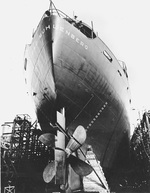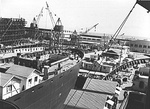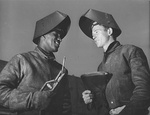California Shipbuilding Corporation
| Type | 272 Shipyard | |
| Historical Name of Location | Los Angeles, California, United States | |
| Coordinates | 33.761111000, -118.251389000 |
Contributor: David Stubblebine
ww2dbaseStarting in 1936, the coordination of merchant shipbuilding in the United States was the function of the US Maritime Commission. But during the Great Depression of the 1930s, American shipbuilding was almost non-existent with only 23 ships launched nationwide during the entire decade. By 1940, with Britain already at war with Germany, there was a sudden increase in the demand for ships. In response, the Maritime Commission instituted the Emergency Shipbuilding Program that immediately authorized and funded nine emergency shipyards across America. Over the course of World War II, the number of shipyards grew, and existing shipyards were expanded, with the total number of yards ultimately reaching 53.
ww2dbaseDuring the initial phase, one contract went to engineering giant Bechtel-McCone in Feb 1941 for a west coast yard on Terminal Island in Los Angeles, California. Known formally as the California Shipbuilding Corporation, this enterprise was universally known as CalShip.
ww2dbaseTerminal Island was a marshy, weed-covered island with one end in the San Pedro neighborhood of Los Angeles and the other in the City of Long Beach. Just inland was what had once been the township of Wilmington but this neighborhood was annexed into the City of Los Angeles in 1909 at the same time as San Pedro. Terminal Island was the primary location for west coast fish canning in the 1920s and 1930s and was also no stranger to shipbuilding, the Bethlehem Shipbuilding Corporation yard having occupied the west end of the island since 1918. The island had gone by several names in its history, including Rattlesnake Island and Fish Island, and was more than doubled in size with infilling during the early twentieth century. The section known as Fish Harbor had been home to an active Japanese-American fishing community since 1906 and these people were among the first to be evacuated en masse after the Pearl Harbor Attack, even before the Executive Order authorizing the relocation.
ww2dbaseBechtel-McCone began building their shipyard on 175 acres of north-central Terminal Island that required extensive additional fill and the driving of 57,000 piles. CalShip's first keel was laid 24 May 1941 and would become the Liberty-ship John C Fremont. To accommodate the increasing pace of production, the Maritime Commission's second wave of expansion authorized CalShip's initial six shipways to be expanded to fourteen. CalShip would go on to produce 336 Liberty-class ships (30 of which were finished as Type Z-ET1-S-C3 tankers) plus another 131 ships of the Victory-class (30 of which were finished as Haskell-class attack transports). Much of the steel CalShip needed came from Henry Kaiser's nearby Fontana steel mill.
ww2dbaseAs with all wartime industry in California, CalShip attracted many workers from outside the region including many women, African-American, Hispanic, and Asian workers. On 29 Sep 1942, CalShip launched the Liberty-ship Booker T Washington, the first Liberty-ship to be named for an African-American. Many of the yard's African-American workers helped build this ship, the ship's sponsor was a prominent African-American opera star, and once the ship entered service, she was commanded by an African-American master.
ww2dbaseWith the end of World War II, nearly all of the Maritime Commission shipyards started closing operations. CalShip's last ship, Council Bluffs Victory, left the yard on 27 Oct 1945. In 1947, the CalShip location was occupied by the National Metal & Steel Corporation which operated a scrap yard. Ironically, 55 of the 467 ships built at CalShip were scrapped at the same location. The area has since been absorbed into the sprawling container-ship terminal that makes up the Ports of Los Angeles and Long Beach.
ww2dbaseTwo ships built at CalShip survive today as museum ships; the American Victory in Tampa, Florida and the Lane Victory in Los Angeles, California.
ww2dbaseSources:
Los Angeles Maritime Museum
Los Angeles Harbor Department
United States Maritime Commission
United States Navy
Spartacus Educational
Shipbuilding History
Auke Visser's Tanker Pages
San Pedro News-Pilot; 12 Dec 1944
Wikipedia
Last Major Update: Aug 2022
California Shipbuilding Corporation Interactive Map
Photographs
 |  |  |  |
California Shipbuilding Corporation Timeline
| 24 May 1941 | Bechtel-McCone’s California Shipbuilding yard at Terminal Island (CalShip) laid down its first keel. The ship would go on to become the Liberty-ship John C Fremont. |
| 28 Mar 1944 | USS Haskell, first ship of her class of Attack Transports, was laid down at California Shipbuilding in Wilmington, California, United States. |
| 24 May 1945 | Victory ship American Victory was launched at the CalShip yards, Los Angeles, California. [Currently a museum ship in Tampa, Florida] |
| 31 May 1945 | Victory ship Lane Victory was launched at the CalShip yards, Los Angeles, California. [Currently a museum ship in Los Angeles, California] |
| 27 Sep 1945 | The last ship of 467 produced at CalShip, Council Bluffs Victory, was launched at Terminal Island, Los Angeles, California, 3 years almost to the minute after the yard's first ship was launched. |
Please consider supporting us on Patreon. Even $1 per month will go a long way! Thank you. Please help us spread the word: Stay updated with WW2DB: |
Visitor Submitted Comments
All visitor submitted comments are opinions of those making the submissions and do not reflect views of WW2DB.
| WW2-Era Place Name | Los Angeles, California, United States |
| Lat/Long | 33.7611, -118.2514 |
 |
- » 1,167 biographies
- » 337 events
- » 44,601 timeline entries
- » 1,243 ships
- » 350 aircraft models
- » 207 vehicle models
- » 376 weapon models
- » 123 historical documents
- » 261 facilities
- » 470 book reviews
- » 28,511 photos
- » 367 maps
Winston Churchill
Please consider supporting us on Patreon. Even $1 a month will go a long way. Thank you!
Or, please support us by purchasing some WW2DB merchandise at TeeSpring, Thank you!
20 Apr 2023 08:58:13 AM
were there any homes taken or families displaced to create any of Kaiser's four California shipyards?